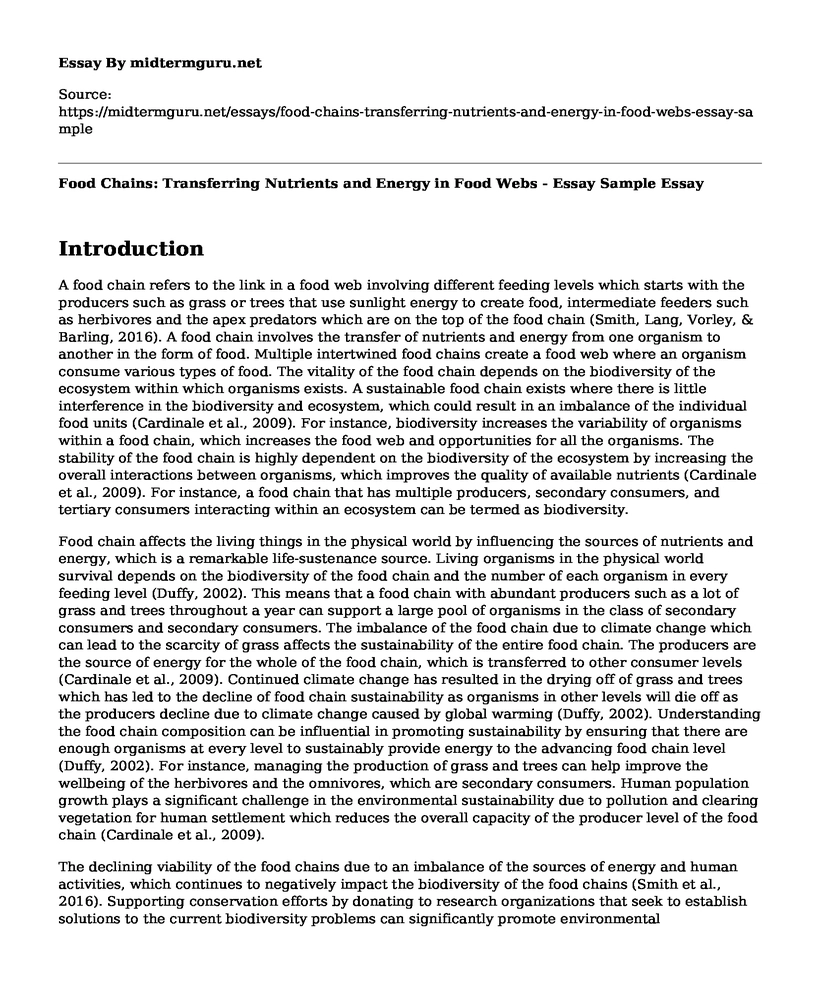Introduction
A food chain refers to the link in a food web involving different feeding levels which starts with the producers such as grass or trees that use sunlight energy to create food, intermediate feeders such as herbivores and the apex predators which are on the top of the food chain (Smith, Lang, Vorley, & Barling, 2016). A food chain involves the transfer of nutrients and energy from one organism to another in the form of food. Multiple intertwined food chains create a food web where an organism consume various types of food. The vitality of the food chain depends on the biodiversity of the ecosystem within which organisms exists. A sustainable food chain exists where there is little interference in the biodiversity and ecosystem, which could result in an imbalance of the individual food units (Cardinale et al., 2009). For instance, biodiversity increases the variability of organisms within a food chain, which increases the food web and opportunities for all the organisms. The stability of the food chain is highly dependent on the biodiversity of the ecosystem by increasing the overall interactions between organisms, which improves the quality of available nutrients (Cardinale et al., 2009). For instance, a food chain that has multiple producers, secondary consumers, and tertiary consumers interacting within an ecosystem can be termed as biodiversity.
Food chain affects the living things in the physical world by influencing the sources of nutrients and energy, which is a remarkable life-sustenance source. Living organisms in the physical world survival depends on the biodiversity of the food chain and the number of each organism in every feeding level (Duffy, 2002). This means that a food chain with abundant producers such as a lot of grass and trees throughout a year can support a large pool of organisms in the class of secondary consumers and secondary consumers. The imbalance of the food chain due to climate change which can lead to the scarcity of grass affects the sustainability of the entire food chain. The producers are the source of energy for the whole of the food chain, which is transferred to other consumer levels (Cardinale et al., 2009). Continued climate change has resulted in the drying off of grass and trees which has led to the decline of food chain sustainability as organisms in other levels will die off as the producers decline due to climate change caused by global warming (Duffy, 2002). Understanding the food chain composition can be influential in promoting sustainability by ensuring that there are enough organisms at every level to sustainably provide energy to the advancing food chain level (Duffy, 2002). For instance, managing the production of grass and trees can help improve the wellbeing of the herbivores and the omnivores, which are secondary consumers. Human population growth plays a significant challenge in the environmental sustainability due to pollution and clearing vegetation for human settlement which reduces the overall capacity of the producer level of the food chain (Cardinale et al., 2009).
The declining viability of the food chains due to an imbalance of the sources of energy and human activities, which continues to negatively impact the biodiversity of the food chains (Smith et al., 2016). Supporting conservation efforts by donating to research organizations that seek to establish solutions to the current biodiversity problems can significantly promote environmental sustainability. At a personal level, using clean energy such as solar energy and switching off lights during the day can curtain climate change, which will improve the vitality of the food chains by reducing environmental pollution. Community education regarding the importance of retaining natural landscapes and using clean energy in cities and towns as policies can help to reduce global warming (Smith et al., 2016). Besides, at the national level increasing funding for conservation organizations can be instrumental in understanding the environment which can improve the sustainability of the current ecosystem biodiversity and improve the overall wellbeing of food chains (Smith et al., 2016).
References
Cardinale, B., Duffy, E., Srivastava, D., Loreau, M., Thomas, M., & Emmerson, M. (2009). Towards a food web perspective on biodiversity and ecosystem functioning. Biodiversity, Ecosystem Functioning, and Human Wellbeing, 60(40), 105. Retrieved from https://books.google.com/books?hl=en&lr=&id=EaoVDAAAQBAJ&oi=fnd&pg=PA105&dq=Towards+a+food+web+perspective+on+biodiversity+and+&ots=5MdpdEKc3_&sig=TjTldD6CTlryVs8Pa9CalY_egYo
Duffy, J. E. (2002). Biodiversity and ecosystem function: the consumer connection. Oikos, 99(2), 201-219. Retrieved from https://onlinelibrary.wiley.com/doi/abs/10.1034/j.1600-0706.2002.990201.x
Smith, J., Lang, T., Vorley, B., & Barling, D. (2016). Addressing policy challenges for more sustainable local-global food chains: Policy frameworks and possible food "futures". Sustainability, 8(4), 299. Retrieved from https://www.mdpi.com/2071-1050/8/4/299
Cite this page
Food Chains: Transferring Nutrients and Energy in Food Webs - Essay Sample. (2023, Feb 01). Retrieved from https://midtermguru.com/essays/food-chains-transferring-nutrients-and-energy-in-food-webs-essay-sample
If you are the original author of this essay and no longer wish to have it published on the midtermguru.com website, please click below to request its removal:
- Essay Sample on Nutrition
- Diabetes Research Paper
- Employee Insurance in Germany: Deduction, Funds, and Coverage - Essay Sample
- The Perils of Plastics: How Our Everyday Habits Impact Our World - Research Paper
- 25 Years of Improving Community Health Through Collaboration - Essay Sample
- Greta Thunberg: Global Climate Activist at 16 - Essay Sample
- Making Professional Partnerships Work: Communication & Decision Making - Research Paper







